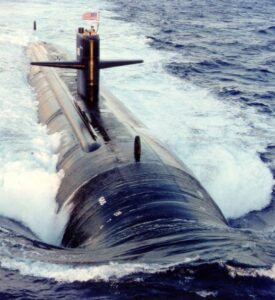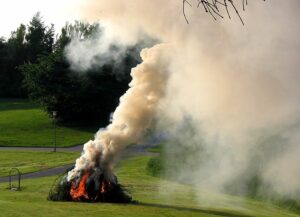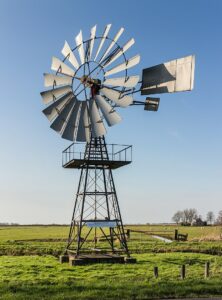In our surroundings most of the flows of the viscous fluids are examples of turbulent flow. Examples of turbulent flow mainly flow via very small size ways and the flow will be slower than the regular.
12+ Examples of Turbulent Flow is listed below,
- Flow of the lava
- Flow of the blood in arteries
- Transpiration of oil through the pipelines
- Flow in the wake of the boat
- Aircraft wing tips
- Currents in the atmosphere
- Currents in the ocean
- Smoke
- Car exhaust
- Rivers
- Air flow through the air conditioning system
- Windmill
What is the meaning of turbulent flow?
Turbulent flow mainly occurs when excessive amount of kinetic energy is present in the flow of motion in the fluids. By the help of Reynolds number the flow of turbulent can be easily determined in the fluid.
Turbulent flow can be explain as, the fluid or in turbulent water an unbalanced situation is appear in restlessness or compound of two or than two liquid substance. For the reason of the restlessness of the fluid the velocity, pressure and other physical parameters are not same at the each point of the fluid.

Image Credit – Wikipedia
If the value of the Reynolds number is more than 3500 then the type of fluid known as turbulent flow.
In which factors the flow of the turbulent is dependent?
The factors the flow of the turbulent is dependent is listed below,
The factors are briefly discuss,
Velocity:
The flow of turbulent is depends on the physical property of velocity. The relationship with the flow of turbulent and velocity is proportional to each other. Means if the rate of velocity is increases then the value of flow of turbulent is also increases and if the rate of velocity is decreases then the value of flow of turbulent is also decreases.
Viscosity:
The flow of turbulent is depends on viscosity. The relationship with the flow of turbulent and viscosity is indirectly proportional to each other. Means if the rate of viscosity is increases then the value of flow of turbulent is decreases and if the rate of viscosity is decreases then the value of flow of turbulent is increases.
Pressure:
Another parameter where the flow of turbulent is depends that is pressure. The relationship with the flow of turbulent and pressure is directly proportional to each other. Means if the rate of pressure is increases then the value of flow of turbulent is also increases and if the rate of pressure is decreases then the value of flow of turbulent is also decrease in the same way.
12+ Examples of Turbulent Flow facts are broadly discuss in below,
Flow of the lava:
In the flow of the lava turbulent flow is appearing. If we observe the flowing condition of the lava then we easily can observe that when lava is came out from the inside of the earth to the surface of the earth that time the particles are not flow in a directional motion the layers of the lava is mixing with each other for this particular reason the physical parameters like velocity, pressure, viscosity is not remain same at each of the molecules of the fluid.

Image Credit – Wikimedia Commons
Flow of the blood in arteries:
In the flow of the blood in arteries the flow of turbulent is present. If we observe the flowing condition of the blood then we easily can observe that when blood is flow through the arteries the particles are not flow in a directional motion. The layers of the blood is mixing with each other for this particular reason the physical parameters like velocity, pressure, viscosity is not remain same at each of the molecules of the fluid and turbulent flow appear.

Transpiration of oil through the pipelines:
In the transpiration of oil through the pipelines flow of turbulent is present. If we observe the flowing condition of fluid then we easily can observe that when fluid is flow through the pipes the particles are not flow in a directional motion.
Flow in the wake of the boat:
In the flow in the wake of the boat the flow of turbulent is present. The flowing condition of fluid is directional motion and the physical parameters like velocity, pressure, viscosity is not remain same at each of the molecules of the fluid and turbulent flow appear.
Aircraft wing tips:
In aircraft wing tips the flow of turbulent is present. The physical parameters like velocity, pressure, viscosity is not remain same at each of the molecules of the fluid and turbulent flow appear.
Currents in the atmosphere:
In the currents of the atmospheric the presence of the turbulent flow can be observe.
Currents in the ocean:
In the currents of the oceans the flow of turbulent is present. The physical parameters like velocity, pressure, viscosity is not remain same at each of the molecules of the fluid and turbulent flow appear.
Smoke:
In the smoke of turbulent is present. When smoke is mix with the surrounding the physical parameters like velocity, pressure, viscosity is not remain same at each of the molecules of the fluid and turbulent flow appear.

Image Credit – Wikimedia Commons
Car exhaust:
In the flow of the car exhaust flow of turbulent is present. When smoke is emitted from the vehicle smoke is mix with the surrounding the physical parameters like velocity, pressure, viscosity is not remain same at each of the molecules of the fluid and turbulent flow appear.
Rivers:
In river water the layers are mix with each other and turbulent flow is present.

Image Credit – Wikimedia Commons
Read more about Mass Flow Rate : Its Important relations and FAQs
Air flow through the air conditioning system:
In air flow of ac turbulent is present because the layers are not flow in one direction.
Windmill:
In windmill flow of turbulent is present. When windmill start the surrounding air mix up a turbulence is appear.
Read more about Wind Turbine Efficiency : Complete Insights and FAQs

Image Credit – Wikimedia Commons
Frequent Asked Question:-
Question: – Describe the relation between Reynolds number and flow of the fluid.
Solution: – Reynolds number is dimensionless physical factor. By the using Reynolds number easily can estimate the type of the flow of viscous fluid. The Reynolds number easily can understand us the flow is laminar or turbulent.
The relation between Reynolds number and flow of the fluid is given below,
Where,
Re = Reynolds number
ρ = Density for the viscous fluid
V = Characteristic velocity for the viscous fluid
L = Characteristic length for the viscous fluid
μ = Dynamic viscosity for the viscous fluid
v = Kinematic viscosity for the viscous fluid
The change of state middle of the dynamic viscosity and kinematic viscosity is given below,
v = μ/ρ
Reynolds number:-
Reynolds number can be deriving as the ratio between the inertia force and viscous force.
Mathematically Reynolds number can be written as,
Re =ρuL/μ
Where,
Re = Reynolds number
ρ = Density of the viscous fluid
u = Speed of flow of the viscous fluid
L = Characteristics linear dimension of the viscous fluid
μ = Dynamic viscosity of the viscous fluid
With the help of Reynolds number we can estimate several properties of the fluid such as viscosity, velocity, length, pressure and many others.
Read more about Reynolds number : It’s 10+ Important facts
Question: – Write the major difference between flow of laminar and flow of turbulent.
Solution: – The major difference between flow of laminar and flow of turbulent is discuss below,
| Parameters | Laminar flow | Turbulent flow |
| Reynolds number | Less than 2000 | Greater than 4000 |
| Viscosity | Low | High |
| Movement of the molecules in the liquid substance | Regular movement is present | Irregular movement is present |
| Mathematical analysis | Easy to do | Complication is appear |
| Motion Direction | Layers of the flow of the water is flow in one direction and no mixing of the liquid is occur | Average motion is present and that is not one directional and mixing of the liquid is occur |
| Occur | Small size diameter rod | Bigger size diameter rod |
| Shear stress | Shear stress of the flow of laminar is depending on the viscosity of the liquid substance and not depends on the liquid substance density. | Shear stress of the flow of turbulent is depending on the density of the liquid substance. |
Hi..I am Indrani Banerjee. I completed my bachelor’s degree in mechanical engineering. I am an enthusiastic person and I am a person who is positive about every aspect of life. I like to read Books and listen to music.